The 'Penny' books by A.Stephen Tring
Article by Jim Mackenzie
A. Stephen Tring was just one of several pseudonyms adopted by Laurence Meynell. Laurence Meynell was born in 1899 in Wolverhampton. He went to school in Hertfordshire and served in the artillery during the First World War. After spells as an articled clerk in a land agency, an advertising agency and as a teacher he won a literary competition in 1924 that allowed him to take up a career as a professional writer. He served in the R.A.F. during the Second World War and was once mentioned in despatches. Most of his output was for adults but, in spite of this, he still produced a substantial number of children’s books.
His most celebrated children’s character was Penelope Patricia Anderson or “Penny” whom we first meet as a schoolgirl of 10 and whom we leave as a (relatively) responsible young lady of 17.
There are many different editions of the “Penny” books and they are most commonly available in the Goodchild reprints.
However, the correct order of publication and the order in which to read them is as follows:-Penny Dreadful (Oxford University Press) 1949Penny Triumphant (Oxford University Press) 1953Penny Penitent (Oxford University Press) 1953Penny Puzzled (Oxford University Press) 1955Penny Dramatic (Oxford University Press) 1956Penny In Italy (Oxford University Press) 1957Penny and the Pageant (Oxford University Press) 1959Penny Says Goodbye (Oxford University Press) 1961.
For those of you meeting Penny for the first time it is both essential and convenient for you to start the story with “Penny Dreadful”. It is essential because, as mentioned above, Penny grows up as we read the stories. Tring often shows quite a different approach to Penny and her world as the years roll by. It would be a real shame to put the cart before the horse and anticipate the way she develops. It is also“convenient” to start with “Penny Dreadful” because a quick survey of on-line booksellers would reveal that there are more copies of that volume available than the rest of the “Penny” books put together.
So what should you expect ? The best comparisons are probably with the “Susan” books by Jane Shaw or the “Jennings” books by Anthony Buckeridge. The humour is less broad and the situations somehow less frantic than with the eponymous protagonists of those two series. There is a greater concern with the world of adults but the sheer unpredictability of parents, teachers, shopkeepers, policemen, neighbours, artists, actors and foreigners is a part of the rich tapestry that the author weaves together. Perhaps the most satisfactory element is that Penny can be seen to be growing up and changing as the reader moves further into the series.
Penny Dreadful The opening story in the “Penny” series is as much about her elder sister, Felicity, as it is about ten-year old Penny. Fizzy has just returned from a year in Belgium and, at the ripe old age of 17, had decided that she must stop being a drain on the Andrews family and get a job. Mr. Andrews is a local solicitor with many connections in the surrounding towns and villages (The setting is a fictionalised Buckingham.) that we meet during the course of the “Penny” saga.
However, Felicity is determined to make her own way in the world and secures her first job purely by chance when she responds to an advertisement in a bookshop window.
The owner is Captain Donald Western, a man of uncertain age, who has newly established the business in the town. Fizzy’s youth, charm and good looks, together with some rather basic secretarial skills, prove to be perfectly fitted for doing the accounts and managing the customers. Captain Western is often absent attending book-sales around the surrounding county. It isn’t long before Fizzy discovers that there is a mysterious back room that she is not allowed to enter. She also has misadventures with shop-lifters who turn out to be quite different from what they first seem.
Meanwhile Penny pursues her usual eventful life at school whilst her mind is entirely pre-occupied with the never-ending problem of persuading her father to buy her a pony. The obsession leads her into all sorts of mischief – some of it harmless and innocent and some of it more wilful and dangerous. A forbidden trip to London to attend a Horse Show in Islington also allows her to blunder across the vital clue that leads to the unmasking of a villain and to her sister’s unemployment. It also makes Penny confront for the first time the penalties of her own conscience.
The portrait of Fizzy is an engaging one of a young girl on the threshold of adult life. She is presented as good-hearted, naïve and easily susceptible to the charms of a pleasant rogue. In the background is Tony Grant, her childhood friend, who is ready to offer the much-needed friendship and attention when the crisis comes.
Penny Triumphant
By the age of twelve Penny has become a much more determined character and it is this determination and resourcefulness that sees her through when events involving her family and the neighbours seem to promise disaster. Penny’s mother, a bastion of the local Women’s Institute, plays a much larger part in this story that the first one. Her sister Fizzy by contrast fades into the background, though we are told she is busy dealing with “a constant stream of young men” who are all anxious to take her out.
Penny’s two preoccupations continue to be the ownership of her pony and the consumption of a large amount of food. She attends the Meadows School where too often she daydreams about belonging to the local County Association of Young Riders. An episode near the beginning of the book where Penny rises early to watch the “cubbing” of the local hunt brings her a whole new set of acquaintances. First there is Mr. King - a recluse who lives in the forest and who has decidedly anti-hunting views that the author allows him to express with clarity and passion. The rest of the book demonstrates that Mr. King is honest, trustworthy and in tune with his natural surroundings.
More unpredictable is Miss Marchant, the lady who lives in the local big house and who, because of her deafness falls into disagreement with Penny’s mother. Penny soon finds herself in the unenviable position of being sympathetic to both points of view in the local dispute. At school she finds herself at enmity with Valerie Summers-Wilson and plunged into the mystery of the gyms shoes when she starts a detective agency with her best friend. By the end of the book she has also drawn in a film star, a hairdresser and a thief. However, as the title indicates, Penny ultimately emerges unscathed and with her reputation enhanced.
Penny Penitent
It is Summer Term at the Meadows School and Penny Andrews is in trouble. This is a fairly normal state of affairs for this young lady. However, the everyday mishaps of school life have been compounded by the arrival of a new form teacher and the promotion of a deadly enemy to the position of form captain. Penny is now nearly fourteen and her family begin to expect herto be more responsible. Things don’t get off to a good start when Penny realises that new teacher is the woman she accused the previous day of stealing her bike. (Incidentally Penny calls the bike by the name of “Tom” and treats it as an old pony rather than a mere machine.)
A school prank that goes wrong leads to an uncomfortable interview with Miss Crane, the Headmistress of the Meadows. Penny is reduced to self-reproach by the very “niceness” of Miss Crane and vows to do all she can to raise money for the new school hall. This leads to her brief and secret career as an artist’s model and to her inadvertently introducing a romantic interest into the life of her endlessly-patient form teacher. All the action culminates in the events of a Sports Day where Penny knows the bitterness of defeat and the sweet taste of victory. In her case it is an ice-cream provided by Tony Grant, still resolute in his pursuit of the nowglamorous-looking Fizzy.
Penny Puzzled
For the first time this story takes our heroine away from her home ground in Buckinghamshire and on a trip to stay with a family in coastal Suffolk. No sooner has she got on to the small branch-line leading to the East Anglian resort than she finds herself embroiled in a mystery about a stolen painting. She quickly makes friends with Elizabeth and David Bale and fits comfortably into the life of the family. For the first time the reader sees signs that Penny is beginning to think about her appearance. The delights of a new dress and the opportunity for wearing it at a special dance are ideas that would never have crossed the mind of the younger Penny. The villain of the piece is easy to spot from the beginning but the dramatic intervention of a flood causes an exciting episode that makes Penny realise that every one has a mixture of qualities that go into their character. There are signs that Penny is growing up, though the author maintains a lot of the comic element by the dialogue between Penny and young David who spends most of his time coming up with impossible inventions.
Penny Dramatic
Just how did Penny Andrews, the dreamy-headed, mischievous nuisance become head of the Fifth Form ? More than any of the other adventures in the series Penny gets into difficult situations not because of faults in her own character but because of the dictates of a seemingly malignant fate. Two passions have now overtaken Penny’s life – one is learning how to be a good actress and the other is playing a full part on the school tennis team. Lots of the plot is about the build-up to the performance of a play and also about Penny taking part in vital tennis matches. The author stays firmly on the side of realism by granting his heroine only a plausible measure of success in both activities. On the other hand Penny continues to win a multitude of new friends including the lively and attractive Danny Taylor, a junior reporter on the local newspaper. She also crosses the path of a fierce-looking goat and a famous Shakespearean actress. Though a much more responsible young person than ever before, she still manages to do incomprehensibly strange things – like putting out a fire with water from a dog’s bowl !
Penny in Italy
The author constructs the opening of this “Penny” adventure with a good deal of care. The reason for Penny’s departure to foreign climes is a tragic one involving the aftermath of a horse-jumping accident. Continental travel appears to be the one way to re-engage our depressed heroine’s interest in the world around her. The story travels across Europe with Penny gradually emerging from her period of gloom. A romantic glow surrounds the time that Penny spends with her friend and her family near Naples. When Penny is drawn into a mystery, again one surrounding a valuable painting, the reader is soon confident that all her old high spirits will return. Her generous, friendly nature attracts strays of both the human and animal kind. Once again the fates conspire to place her at the centre of events which are by no means under her control. It is disappointing to report that the author, anxious to build up the momentum of Penny’s need to go abroad, wrongly declares that Fizzy was envious of her sister because “Felicity had never herself been abroad at all”. He seems to have entirely forgotten that year in Belgium mentioned in “Penny Dreadful”.
Penny and The Pageant
Once again the author demonstrates that the older Penny is now ready to develop as a person who will be able to live independently from the watching eye of her family. Her summer holidays are spent helping Lady Peterly organise a Pageant and ensuring that by hook or by crook that it will be a success. Using the same plot device of two simultaneous village “happenings” falling on the same day as he used in “Penny Triumphant” the author still manages to skirt the dangers of mere repetition. Penny’s resourcefulness in the face of the hazards of chance is skilfully handled and once again the readers find themselves drawn into admiring her impetuous enthusiasm and high spirits.
Penny Says Goodbye It is not often that an author of series books has the courage to draw a line under his own efforts and say “no more”. The temptation to continue with the adventures of a character who has been very successful with an ever book-hungry audience must have been strong. However, by bringing the saga to a conclusion with “Penny Says Goodbye” A.Stephen Tring kept faith with both himself and his readers. By the last page of this eighth volume Penny has grown up. As she walks away from school for the last time her mother speaks to her.“Ready, Penny ?” her mother asked quietly.Penny Andrews nodded. “Yes,” she answered. “I’m ready.”
And what she really meant was, “I am ready to hear the good news and to see the fine things. I am ready for life.”
William (Richmal Crompton) , Jennings (Anthony Buckeridge) and Susan (Jane Shaw) never grow up. That is almost the essence of their attraction.. The Penny of “Penny Dreadful” is now just a distant memory, though, strangely enough, it is thoughts about herself in the past that give this last tale such poignancy.
In “Penny Says Goodbye” our heroine is now the same age that her sister Fizzy was in the very first book. The awkward gangling shape of the ten-year madcap of the Junior Section of Meadows School has been transformed into an attractive 17 year old. Her driving instructor tells her,“Good looks seem to run in the family, if I may say so.”And Penny has the good grace and good sense to accept the compliment without taking it too seriously or letting it go to her head. Her driving lessons are another measure of her development, for once again Stephen Tring avoids the possibility of creating humour by cataloguing the foolish errors that beginners will make. Penny’s competence and confidence reveal some of the inner resilience of her character. She proves a tower of strength to her family as the arrangements for Fizzy’s wedding draw to their climax. At the same time, whilst taking some of the strain, she doesn’t fail to be moved by the solemnity and beauty of the occasion.
At school too Penny takes on the responsibilities of Head Girl with admirable good sense and good humour. She is not afraid to stick to her principles even when this brings her into conflict with her oldest friend. Though understanding of the sins of the junior pupils, recognising many of her own faults from first form days, she is never indulgent for old time’s sake. She is also able to understand and tolerate some of the least attractive features of the adults around her. A grown-up who cheats at tennis is demonstrated to be a “bad sport” at the same time as Penny learns the useful lesson of self-control and keeping a sense of proportion in difficult circumstances. Most of all she suddenly starts to realise her potential for academic achievement, finding both pleasure and reward in her English and French studies.
The challenge of making a public speech is appalling for her but the new Penny is prepared to face it with the right mixture of trepidation and determination. With her outward-going character and her instinctive friendliness Penny is able to draw together people from all areas of society and create harmony where conflict seemed inevitable.
Strangely enough, as we read the last volume, we begin to realise that the qualities Penny has gained during her last year at school are also reflected in the behaviour and attitudes of her long-suffering parents and in the instinctive understanding of the admirable headmistress who has always guided her along the right path.
It is sad to say goodbye to an old friend but it is fair to conclude that the author gave her a nearly perfect send-off.
Also by Stephen Tring are three adventures charting the career of a grammar school boy called Barry.
Barry's Exciting Year (1951)
Barry Gets His Wish (1952)
Barry's Great Day (1954)
Saturday, 18 April 2009
Subscribe to:
Post Comments (Atom)






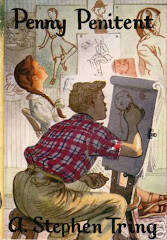


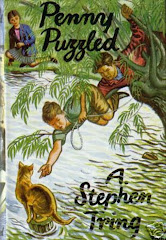
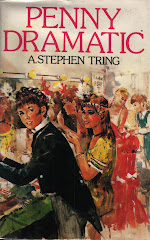
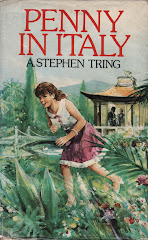

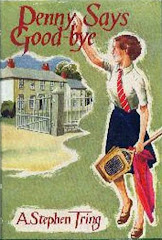

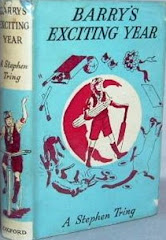
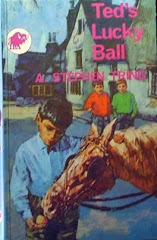
No comments:
Post a Comment